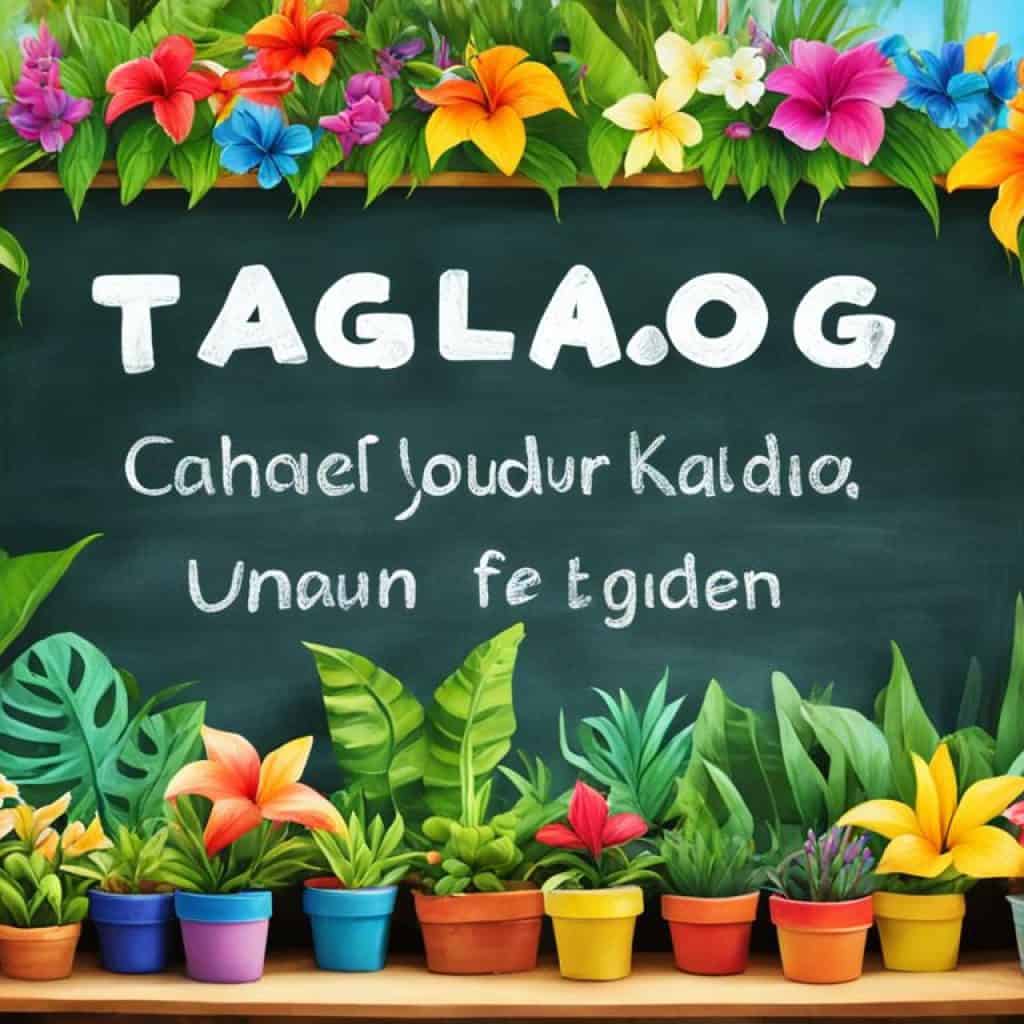Struggling to speak Tagalog well? Translating from English to Tagalog can seem tough. This is due to words changing meaning based on context. Yet, we’ve got you covered! Our guide makes translating English to Tagalog words easy. It will improve how you communicate.
If you’re starting out or just want to get better at Tagalog, this guide is for you. It’s filled with useful advice, handy tips, and the best tools. These will help you overcome language challenges and connect with Tagalog speakers. Ready to dive into the world of Tagalog and broaden your linguistic skills? Let’s get started!
Key Takeaways:
- Learn the importance of constructing Tagalog sentences for effective communication.
- Explore different types of Tagalog sentences, including declarative, interrogative, imperative, and exclamatory sentences.
- Understand the difference between Filipino and Tagalog and their relationship as the national language and dialect.
- Discover the benefits of learning Tagalog, including improved communication and personal and professional opportunities.
- Explore advanced translation tools and resources for enhanced Tagalog-English translations.
The Importance of Learning Tagalog Sentences
Learning Tagalog sentences is vital for clear communication. It’s not just about words and phrases. You need to get the sentence structure right to fully express your thoughts. Tagalog’s flexibility means word meanings can change. So, correctly forming sentences is a big step towards fluency.
In both formal and casual Tagalog talks, knowing how to build basic sentences really helps. For formal situations, like business, correct grammar shows respect and professionalism. But, informal chats can be more relaxed.
An example can show why learning Tagalog sentences matters:
Formal interaction:
Employer: “Tag-araw na, napaka-init ng panahon. Ano ang paborito mong gawin kapag mainit ang panahon?”
Employee: “Sa ganitong panahon, mas gusto kong maglibot sa mga puno at mamasyal sa labas.”
(English translation: “It’s summer, and the weather is scorching. What’s your favorite thing to do when it’s hot?”
Employee: “During this weather, I prefer wandering around trees and strolling outside.”)
Casual interaction:
Friends hanging out:
Friend 1: “Grabe ang init ngayon! San tayo pupunta para makapagpalamig?”
Friend 2: “Game ako sa mall, malamig dun!”
(English translation: “It’s so hot today! Where should we go to cool down?”
Friend 2: “I’m up for going to the mall, it’s cool there!”)
Basic Tagalog Sentence Structures
Knowing the basics of Tagalog sentence structures helps in making sentences.:
- Subject-Verb-Object (SVO): “Si Juan (subject) kumain (verb) ng mangga (object).” (English: “Juan ate a mango.”)
- Subject-Object-Verb (SOV): “Ang bata (subject) kinuha (verb) ang laruan (object).” (English: “The child took the toy.”)
- Verb-Subject (VS): “Dumating (verb) na si Maria (subject).” (English: “Maria arrived.”)
- Adjective-Noun (AN): “Malaki (adjective) ang bahay (noun).” (English: “The house is big.”)
Mastering these structures makes learners ready for meaningful Tagalog conversations.
Declarative Sentences in Tagalog
Declarative sentences, or “pasalaysay” and “paturol” in Tagalog, share facts, opinions, or statements. They are simple and usually end with a period.
These sentences are key in Tagalog communication. They help speakers share information and thoughts clearly. They are used in talking about daily life, personal stories, or observations.
Tagalog Declarative Sentence Examples:
“Pupunta ako sa tindahan.” (I am going to the store.)
“Wala akong magandang damit.” (I don’t have nice clothes.)
“Nilalarawan ko ang paglipad ng paru-paro.” (I am describing the flight of a butterfly.)
Declarative sentences let people share information, views, and stories easily. Their clear and direct nature makes them great for everyday talk and writing.
Knowing how to use these sentences in Tagalog is key for good language skills. Now, let’s look at interrogative sentences, another common sentence type in Tagalog.
Interrogative Sentences in Tagalog
In Tagalog, asking questions involves using “patanong” or interrogative sentences. These sentences help you ask for information or start a chat. You can spot an interrogative sentence by looking for the question mark (?). This shows a question is on its way.
Curious where someone is headed? Or if they can chat in Tagalog? Perhaps you wonder about the cost of taro per kilo. With interrogative sentences, gathering info and engaging in talks becomes smoother.
Here are some classic examples of interrogative sentences in Tagalog:
“Saan ka pupunta?” (Where are you going?)
“Alam mo ba magsalita ng Tagalog?” (Do you know how to speak Tagalog?)
“Magkano ang presyo ng isang kilong gabi?” (What is the price of a kilo of taro?)
Get good at these and asking questions in Tagalog becomes second nature to you.
Interrogative Sentence Structure
Tagalog questions have a structure close to English’s. Usually, the order goes like this:
- Question word or phrase
- Auxiliary verb (if necessary)
- Subject
- Main verb
- Complement or extra details
Examples include:
“Anong oras na?” (What time is it?)
“Kailangan mo ba ng tulong?” (Do you need help?)
Tips for Using Interrogative Sentences
When crafting questions in Tagalog, here are some handy tips:
- Ask with a rising pitch to show it’s a question.
- Always be polite and show respect, especially when you’re talking to new people or in official situations.
- Choose your question words wisely. Think of “sino” (who), “saan” (where), “kailan” (when), “paano” (how), and “magkano” (how much).
- Match your question’s tone to the situation, whether it’s chill talks with friends or serious discussions.
Using questions effectively in your talks will boost your language skills and help you connect better with those who speak Tagalog.
Imperative Sentences in Tagalog
Imperative sentences are called “pautos” or “pakiusap” in Tagalog. They are crucial for giving commands or asking for things. They let you instruct someone in a kind way.
Some examples of imperative sentences in Tagalog are:
“Paki-sara ang pinto.” (Please close the door.)
“Pakisampay na lang mamaya.” (Please hang the clothes later.)
“Pakituruan mo ako kung paano gawin ito.” (Please teach me how to do this.)
Imperative sentences are handy in many situations. They help with giving directions, asking politely, or sharing what you prefer. With them, you can clearly state what you want in Tagalog.
Common Phrases Used in Imperative Sentences:
Here are familiar phrases for making imperative sentences in Tagalog:
- Paki-: Please (to start a polite request)
- Bigyan mo ako ng-: Give me (to ask for something)
- Turuan mo ako ng-: Teach me (to request learning)
- Gawin mo ito-: Do this (for direct commands)
- Tulungan mo ako-: Help me (when seeking help)
Using these phrases will make your imperative sentences polite and respectful in Tagalog.
| Tagalog | English |
|---|---|
| Pakibaba ang telebisyon. | Lower the television. |
| Pakikantot ito ngayon. | Please clean this now. |
| Paki-abot ang tubig. | Pass me the water, please. |
| Pakigawa ng report para bukas. | Create the report by tomorrow. |
Exclamatory Sentences in Tagalog
“Padamdam” in Tagalog means exclamatory sentences. They convey strong feelings in an expressive way. These sentences catch attention and bring out drama. They let people share their deepest feelings like joy or love.
In daily talks, Tagalog speakers use exclamatory sentences to express intense feelings. They help emphasize feelings and catch the listener’s interest.
“Oh, what a delightful surprise it is to see you!”
“Mabuhay! I’ve missed you all so much!”
“Watch out! There’s a fierce dog running towards us!”
These sentences can express joy, love, or warn of urgency. They are a key tool in showing deep emotions or highlighting urgent matters. This adds passion and energy to conversations, making them more lively and emotional.
Expressing Emotions with Padamdam Sentences
Padamdam sentences can bring out strong feelings. They use dramatic words to show emotion’s intensity and authenticity. This way, emotions gain depth and feel more real.
They’re perfect for showing happiness, surprise, anger, or gratitude. Padamdam sentences let people share raw feelings. They connect speakers and listeners authentically.
At their core, padamdam sentences express the heart’s true feelings. They enrich how we share our thoughts and emotions, improving communication and relationships.
| Examples of Exclamatory Sentences in Tagalog |
|---|
| “Ang galing ng pag-awit mo!” |
| “Sarap ng luto mo! Ang sarap ng sinigang mo!” |
| “Ang ganda ng tanawin dito! Sobrang breathtaking!” |
Filipino vs. Tagalog: Understanding the Language
The Philippines’ national language is Filipino. It’s made up of different dialects from around the country. Though Filipino and Tagalog are often seen as the same, there are minor differences.
While not all Filipinos can speak Tagalog, it is the most widely used language in the country, especially in cities like Manila.
Tagalog plays a big role in the Filipino language. It’s like the base of Filipino, adding words and grammar rules. If you learn Tagalog, talking to people in the Philippines becomes easier.
Filipino and Tagalog, despite their differences, can be understood by speakers of each. This allows everyone to chat and understand each other.
Dialects in the Philippines
The Philippines has many dialects, thanks to its varied culture and landscape. Some major ones include:
- Cebuano
- Ilocano
- Hiligaynon
- Waray
- Bikol
Every dialect is unique and used in different parts of the country. But knowing Tagalog helps you communicate all over the Philippines.
The Importance of Language in the Philippines
With over 180 languages, the Philippines is full of linguistic diversity. Filipino and English are official, but local dialects are key in daily chat.
Learning Tagalog can help bridge the language barrier and foster better understanding and relationships, especially with the majority of Filipinos who speak Tagalog.
In places like Manila, Tagalog is everywhere. Knowing basic Tagalog helps in daily tasks. It’s useful for things like buying food, finding places, or small talk.
Also, learning Tagalog shows you respect the local culture. It builds stronger ties with Filipinos. And it lets you enjoy the country’s history, traditions, and people more.

Comparing Filipino and Tagalog
Let’s look at how Filipino and Tagalog differ:
| Filipino | Tagalog |
|---|---|
| Official national language | Major regional dialect |
| Incorporates vocabulary from various dialects | Derived from Tagalog with some variations |
| Used in schools, media, and government | Used in daily conversations and informal settings |
| Mutually intelligible with other Philippine languages | Mutually intelligible with other Philippine languages |
Filipino and Tagalog have their unique features but are both vital. They connect you to the Philippines’ rich culture and diverse communities.
The Benefits of Learning Tagalog
Learning Tagalog offers several benefits. One key benefit is better communication with Filipinos, especially in urban areas. Tagalog is spoken by a large part of the Philippines’ population.
Being able to speak Tagalog helps build rapport and strengthen relationships. It also lets you understand Filipino culture more deeply.
Tagalog is relatively easy for Spanish speakers to learn. This is because Spanish has influenced Tagalog. The vocabulary and grammar share many similarities.
This similarity makes learning Tagalog smoother and fun for those who know Spanish.
There are many apps to help you learn Tagalog, like the Ling app. These apps offer tailored resources for learning. They have interactive lessons, guides for pronunciation, and exercises for building vocabulary.
These resources help improve fluency in the language. They also provide chances to practice the language.
Learning Tagalog can open up work opportunities and personal relationships with Filipinos globally. The Philippines is important in outsourcing and international business. Being able to speak Tagalog is a huge advantage professionally.
It also helps create meaningful relationships with Filipino colleagues, friends, and loved ones.
Advanced Tools for Tagalog-English Translation
The Tagalog.com dictionary offers advanced tools for Tagalog-English translation. These features help users improve their language skills in both Tagalog and English.
Tagalog English Dictionary:
The Tagalog.com dictionary provides a strong Tagalog-English dictionary. It has a huge list of words and phrases for translations. It’s great for all learning levels, helping to grow your vocabulary.
Audio Pronunciations:
Correct pronunciation is key for good communication. The dictionary has audio pronunciations for many words. This helps users improve their listening and speaking skills in Tagalog.
Example Sentences:
Knowing how words are used in sentences is important. The Tagalog.com dictionary has over 20,000 example sentences. These examples help users understand sentence structures and idiomatic expressions.
Comprehensive Verb Information:
Verbs are essential in language. The dictionary gives detailed information on verbs, like conjugations and tenses. This helps users accurately express themselves.
Enhanced Search Algorithm:
The dictionary has a special search algorithm for Tagalog. It considers the unique aspects of the language. This makes searching faster and more relevant.
Custom Flash Card Builder:
Learning vocabulary well is crucial. The dictionary includes a custom flash card builder for studying. This tool makes learning Tagalog words and phrases fun and effective.
The Tagalog.com dictionary provides a full language learning experience. It has everything from a great dictionary to audio pronunciations, example sentences, detailed verb information, a powerful search algorithm, and a flash card builder. These tools make learning Tagalog and English efficient and fun.
The Word of the Day Feature
The Tagalog Word of the Day is a special feature of the Tagalog.com dictionary. Each day, it introduces a new Tagalog word. This helps learners grow their vocabulary and improve their language skills.
Each Word of the Day comes with example sentences. These show how to use the word in real conversations. They help learners practice and grasp the word’s usage better.
The feature also includes a pronunciation guide. Learning the right pronunciation can be tricky. But with Tagalog.com, users can listen to how each word sounds. This boosts their confidence in speaking Tagalog.
Moreover, the Word of the Day provides an in-depth look at the word’s meaning. It gives a clear definition and discusses related terms. Knowing these details helps learners understand the language more deeply.
This Word of the Day feature is truly beneficial for expanding your Tagalog vocabulary. Regularly discovering new words, practicing with examples, and learning pronunciation makes mastering Tagalog much easier.

User Contributions and Community Agreement
The Tagalog.com dictionary values user contributions. These help in expanding and improving its content. Fluent Tagalog speakers are crucial in sharing their knowledge.
Being part of this community means following guidelines. These rules ensure the accuracy and integrity of dictionary entries. They also encourage respect and inclusion among users.
Copyright is key to keeping the dictionary authentic and reliable. The Tagalog.com dictionary protects the rights of contributors and the original content. This makes it a trusted resource for learners.
Community Contributions
Contributing to the dictionary is a team effort. It brings together the knowledge of Tagalog speakers. They can suggest new words and provide accurate definitions.
These efforts help the dictionary stay relevant. Users’ contributions ensure it meets the evolving needs of learners.
Community Guidelines
The community guidelines of the Tagalog.com dictionary are important. They set the tone for respectful and constructive interactions. Adhering to these guidelines keeps the community supportive and inclusive.
By following these rules, users help maintain a collaborative environment. This encourages sharing of knowledge and mutual support.
Copyright Protection
The Tagalog.com dictionary takes copyright protection seriously. It respects the rights of contributors and original authors. Implementing copyright measures ensures content is reliable and legally compliant.
This protection enhances the integrity of the dictionary. It improves the user experience for all learners.
Conclusion
This English to Tagalog translation guide is a must-have for anyone wanting to learn the language. It’s especially useful for understanding Tagalog sentences and their meanings. This makes talking with people in Tagalog-speaking areas much easier.
The Tagalog.com dictionary is filled with helpful features like advanced search, pronunciation tips, and example sentences. It also includes contributions from the community. This makes it an excellent tool for anyone learning Tagalog, whether you’re just starting or already know a lot.
With this guide, you can easily handle different kinds of conversations in Tagalog. It doesn’t matter if you’re having a casual talk or a more formal chat. The language resources from the Tagalog.com dictionary can help boost your vocabulary and make you more fluent in Tagalog.
Using this English to Tagalog translation guide and the resources from the Tagalog.com dictionary will improve your language skills. This means you can communicate better with the Tagalog-speaking community. Learning Tagalog is valuable, whether you’re doing it for fun or work. It helps you connect with others and understand their culture better.







Add comment